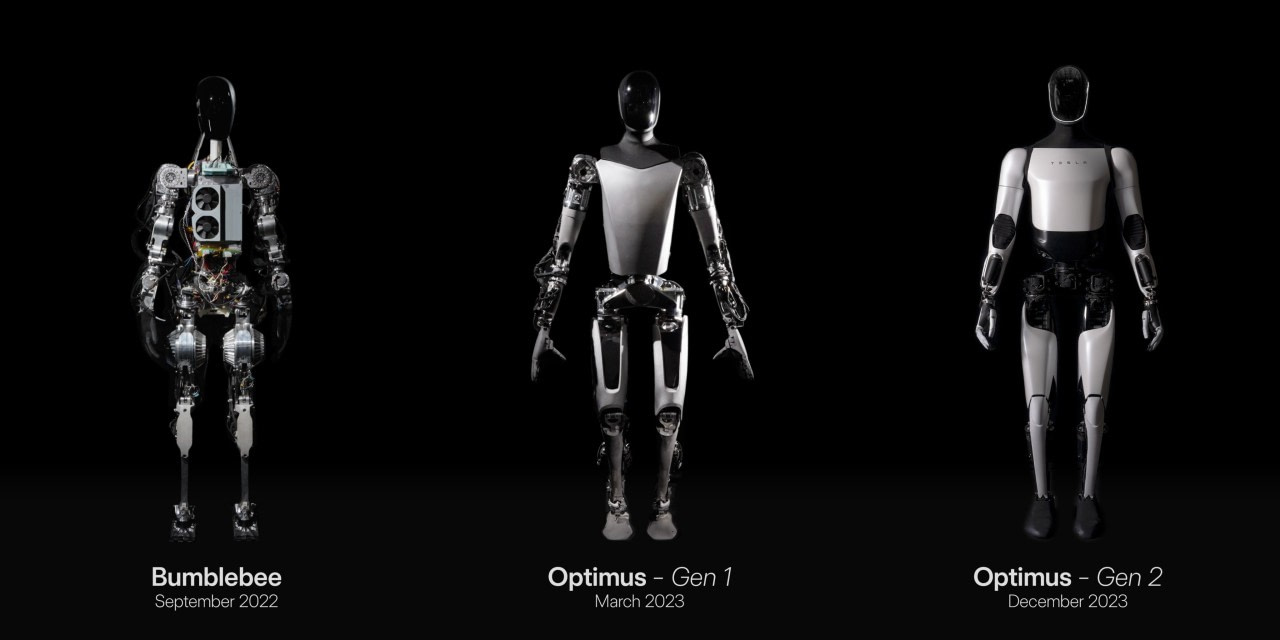As we stand on the precipice of what ARK Invest terms the ‘convergence’ era, the speed of evolution is astounding.
Optimus. The hardware.
Within 31 months since Tesla’s initial announcement in August 2021, we’ve seen two new Optimus robot generations emerge. This pace is not just rapid but unparalleled. Each generation has showcased significant enhancements in motor skills, tactile sensitivity, and now, a commendable walking speed. This is roughly a new generation every 10 month. Tesla’s approach is characteristic of its brand – an unyielding, high-velocity pursuit of innovation. The current iteration of Optimus reveals a robot that’s no longer confined to the drawing board or slow, cautious movements.
Instead, the latest model of Optimus demonstrates a level of dexterity and speed that hints at a future where humanoid robots could effortlessly blend into various facets of daily life. But the advancements at Tesla are just one piece of the global robotics puzzle.
We must acknowledge the world’s fastest robots are not on land but in space – the self-landing and REUSABLE rockets of SpaceX.
But wait there is more. So much more. Robots Everywhere.
The robotics sector as a whole has been quietly undergoing a similar revolution. In adherence to Wright’s Law; Wright’s Law aims to provide a reliable framework for forecasting cost declines as a function of cumulative production. Specifically, it states that for every cumulative doubling of units produced, costs will fall by a constant percentage; so, do industrial robots. As illustrated in Graph 1.
Around the year 2010, the cost curve for robots steepened significantly, entering the steep phase of the S-curve. This price-performance ratio shift is tied to the fact that robots now outperform humans in many labor-intensive tasks. By 2020, as shown in subsequent data visualizations, graph 2, robots had surpassed human performance in warehousing services, such as picking and packing orders.
This efficiency gain is exemplified by the trend at companies like Amazon, where the increase in robot utilization correlates with a slight decrease in human labor.
It doesn’t take much imagination to foresee a near future where robots outnumber humans in Amazon’s warehouses. Robotics is driven by an incredible surge in productivity of 80% or more in tasks ranging from laundry services to car manufacturing, and even in the time it takes for a customer’s online order to leave the warehouse en route to the customer.
Now, consider the convergence of these technologies and the potential market for humanoid robots capable of operating in unstructured environments. Once these robots become affordable enough, the Total Addressable Market (TAM) reaches staggering figures. ARK Invest projects it could rise to $28.5 trillion by 2030. This projection is based on the premise that if humanoid robots attain a general intelligence level, they could expand the global workforce, breaking the current limit set by the human population.
This growth necessitates robots that can understand and interact with their environment and possess, at the very least, rudimentary general intelligence. Herein lies the convergence. Tesla already has robots on the road – roughly 5 million vehicles with partial autonomy that are contributing to the company’s understanding of environmental perception and interaction, laying the groundwork for full autonomy. This AI, developed for vehicular navigation, can be adapted with minimal adjustments to become the operating system – the ‘consciousness’ – of a humanoid robot. This synergy is why Tesla is rapidly developing the hardware for humanoid robots; their software is already advanced. The leap to a humanoid robot is not as vast as it once seemed, thanks to the converging trajectories of autonomous vehicles, artificial intelligence, and robotics, all accelerating and enhancing each other’s capabilities.
In this blog, I refrain from assigning value judgments to the advancements of AI and robotics. I neither endorse nor criticize the unfettered adoption of such technologies nor their potential societal impacts. Instead, I aim to illuminate what appears to be an inevitable shift within the next six years—a shift potent enough to fundamentally alter the global economy. It’s a topic that merits discussion, but for now, my objective is simply to inform, to bring awareness to the monumental changes unfolding before us, often unnoticed by the many.







